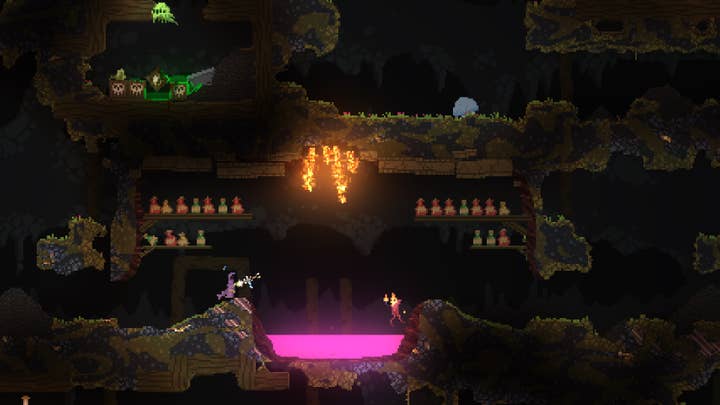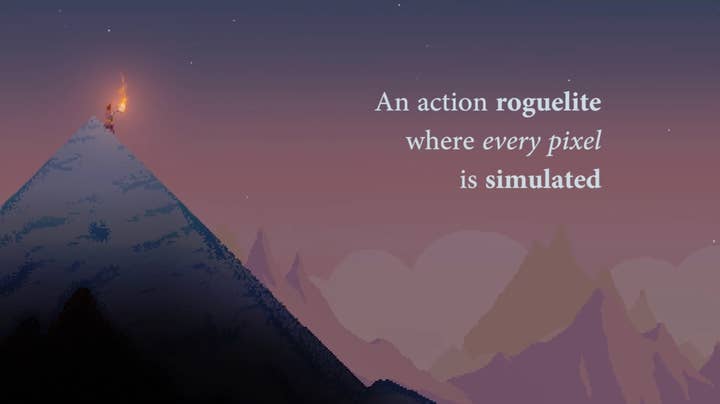Noita from idea to execution in a dozen years (and counting)
Nolla Games' Petri Purho recounts game's winding path from conception as a zombie game feature to IGF-nominated rogue-lite
If you're comparing attention-grabbing taglines for games, it's hard to beat Nolla Games' description of its upcoming Noita:
"A magical action rogue-lite where every pixel is simulated."
Like many other rogue-lites, Noita is a 2D side-view action game that has players progress through procedurally generated levels in a variety of themes, and dying means starting the game over from scratch. Unlike those other rogue-lites, the game's hook is a physical simulation system where every pixel has certain physical attributes that interact with the world around it (and the player's actions) in ways that are technically predictable, but will create scenarios that are anything but.
For example, there are enemies in the game that are made of fire, and have lava for blood that splatters when they're attacked. There are also wooden bridges, explosives, water that freezes, acid pits, fully destructible terrain, and more. Oh, and players can cast spells to manipulate the world around them, and alter those spells to their own tastes.
It appears to be an impressive simulation, but speaking with GamesIndustry.biz recently, Nolla programmer Petri Purho said the technical challenges in creating the game have been overshadowed by the design challenges.
"Programming stuff is in some ways a bit easier to do because you have a better [understanding]," he said. "Knowing if it's working is much easier when programming stuff. 'Is this game running at 60 frames per second? It is? This thing works.' But with game design it's much harder to say something's working. If you have these things in the game and they're fun for us to play, that's fine, but does anyone else understand what's happening? Can that be communicated to the player? Is it interesting to other people?"
"Knowing if it's working is much easier when programming stuff... But with game design, it's much harder to say something's working"
That problem has dogged Noita throughout its development, which Purho traces back (informally) to 2007 and Blood Zombies, part of a series of monthly game prototypes he released. It was an action game where players used a lawnmower to cut through zombie hordes, and although it was exceptionally low resolution (128 x 96), it featured a physics simulation for the zombies' blood and incorporated it into the gameplay such that players could surf their lawnmower on the blood, or strategically spill it to solve puzzles.
"It was a fun little project, but when working on it I was curious if I could simulate other things using this technique besides blood," Purho recalled.
The original idea was that the lawnmower would be able to dismember zombies, and then severed limbs could perhaps crawl their way to the player, or zombies would stagger differently toward the player depending on what damage they had sustained and where. That specific execution never materialized, but Purho would revisit the idea some years later. The results were promising enough that he contacted Arvi Teikari (Baba Is You), a fellow creator of small experimental games, and the pair worked on a prototype for a game where players would be wizards who cast spells to alter the world around them.

It was fun, but the spell-casting system was overly complex to the point that it was difficult for players to understand how the events on screen were related to the systems producing them.
"If you're working on a game that's got a lot of emergent systems where all kinds of craziness can happen... it's very easy as a designer to come up with some sort of scheme that sounds really cool, but in practice you haven't thought through all the implications of your idea," Purho noted.
That was demonstrated nowhere better than in the next iteration of the project that would become Noita. After that prototype, The Swapper developer Olli Harjola joined the team and the trio started to explore different types of games to which they could apply the simulation. They tested a god game that Purho described as a 2D side-view take on Populous, with minions and a variety of simulated systems in the game.
"The deer would also urinate from time to time, and they would end up in these ditches, and would urinate so much they'd drown in their own urine"
"We had rain in there, and one of the things you don't realize in 2D is how much volume the rain takes up," Purho said. "So all these ditches would be filled with water, so we needed to have some sort of system to suck the water into the ground. Then we had deer and wolves in the game, and the wolves would hunt the deer down. But the deer would also urinate from time to time, and they would end up in these ditches, and would urinate so much they'd drown in their own urine. And the wolves would poop, but they'd have these mountains of poop because they stayed in one place."
Those unexpected implications then present new design challenges. The developer can add more simulated systems to fix the issues that arose with previous ones, but each such addition only adds a host of new implications for all the other systems it interacts with. Alternatively, the developer can remove systems (potentially making the game's system interactions less interesting in the process) or go back to the drawing board completely.
"In the case of the god game, it was kind of fun messing around in there, but at the same time we couldn't get a nice goal for the game," Purho said. "It would work as a sandbox thing you could mess around with, but it was really hard to figure out... if you're a god and you have a bunch of spells that are fun to use, it was hard to find good limitations to your powers. On the one hand, it was fun to mess around, but that fun of messing around would last maybe 20 minutes. And then you'd be done with it."
They decided to go back to the wizard action game concept, and it was in that process they discovered that converting the game to a rogue-like solved a number of outstanding design problems.
"If the player becomes really powerful [in a rogue-like], that's cool if the game's challenging in a way," Purho said. "That's a nice rewarding feeling. And if the game's challenging, it forces you to pay attention to the world. So now you have to learn how the world works. In the god game example, it was easy to spam your lightning spell everywhere, so you wouldn't need to care that much about understanding the system. It was essentially a cool effect you could do everywhere. But if the game's challenging, you need to understand what happens if these two liquids mix together and they have some sort of reaction. That can be important knowledge and you can use that to your advantage."
Purho can trace the seed of Noita's development back a dozen years, and it will stretch out an undetermined length into the future, with an official release date of "When it's done" on Steam and an expected run in Early Access. Even so, the game is far enough along in development that it was entered into this year's Independent Games Festival awards, where it received nominations in three categories, including the Seumas McNally Grand Prize.


